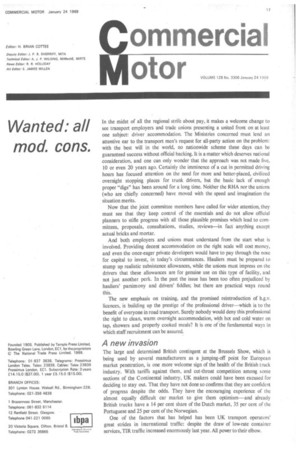ommercial
Page 19

If you've noticed an error in this article please click here to report it so we can fix it.
otor VOLUME 128 No. 3306 January 24 1969 In the midst of all the regional strife about pay, it makes a welcome change to see transport employers and trade unions presenting a united front on at least one subject: driver accommodation. The Ministries concerned must lend an attentive ear to the transport men's request for all-party action on the problem: with the best will in the world, no nationwide scheme these days can be guaranteed success without official backing. It is a matter which deserves national consideration, and one can only wonder that the approach was not made five, 10 or even 20 years ago. Certainly the imminence of a cut in permitted driving hours has focused attention on the need for more and better-placed, civilized overnight stopping places for trunk drivers, but the basic lack of enough proper "digs" has been around for a long time. Neither the RHA nor the unions (who are chiefly concerned) have moved with the speed and imagination the situation merits.
Now that the joint committee members have called for wider attention, they must see that they keep control of the essentials and do not allow official planners to stifle progress with all those plausible promises which lead to committees, proposals, consultations, studies, reviews—in fact anything except actual bricks and mortar.
And both employers and unions must understand from the start what is involved. Providing decent accommodation on the right scale will cost money, and even the once-eager private developers would have to pay through the nose for capital to invest, in today's circumstances. Hauliers must be prepared to stump up realistic subsistence allowances, while the unions must impress on the drivers that these allowances are for genuine use on this type of facility, and not just another perk. In the past the issue has been too often prejudiced by hauliers' parsimony and drivers' fiddles; but there are practical ways round this.
The new emphasis on training, and the promised reintroduction of h.g.v. licences, is building up the prestige of the professional driver—which is to the benefit of everyone in road transport. Surely nobody would deny this professional the right to clean, warm overnight accommodation, with hot and cold water on tap, showers and properly cooked meals? It is one of the fundamental ways in which staff recruitment can be assured.
A new invasion
The large and determined British contingent at the Brussels Show, which is being used by several manufacturers as a jumping-off point for European market penetration, is one more welcome sign of the health of the British truck industry. With tariffs against them, and cut-throat competition among some sections of the Continental industry, UK makers could have been excused for deciding to stay out. That they have not done so confirms that they are confident of progress despite the odds. They have the encouraging experience of the almost equally difficult car market to give them optimism—and already British trucks have a 14 per cent share of the Dutch market, 35 per cent of the Portuguese and 25 per cent of the Norwegian.
One of the factors that has helped has been UK transport operators' great strides in international traffic: despite the draw of low-rate container services, TIR traffic increased enormously last year. All povser to their elbow.








































































































